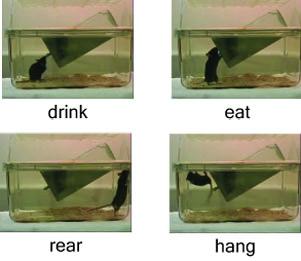PROVIDENCE, R.I. [Brown University] — For decades, carefully logging data about how mice go through the motions of their daily routines has been a tedious staple of behavioral and neuroscience research:
- Hour 2, minute 27: mouse 4 is sleeping;
- Hour 3, minute 12: mouse 7 is eating;
and so on. It’s a task most people would happily cede to automation. Now, says Thomas Serre, assistant professor of cognitive, linguistic and psychological sciences at Brown University, that’s finally possible.
In a paper to be published online Sept. 7, 2010, in the journal Nature Communications, Serre and a team of colleagues at the Massachusetts Institute of Technology and California Institute of Technology describe a new computer system that is as accurate as people in identifying mouse behaviors in videos. What’s more, the team is making the fully customizable open-source software available for free. Given standard camcorder footage of a mouse, the software will automatically identify a mouse’s behavior frame by frame.
“We measured the agreement [on mouse behaviors] between any two human observers and it was more than 70 percent,” said Serre, who joined the Brown faculty in January 2010 after conducting his doctoral and postdoctoral studies, including the work described in the paper, at MIT. “The system agreed with humans at the same level. There was no significant difference between the annotations provided by our system and any two human observers.”
The value of the software is not only that it could relieve graduate students and lab technicians from some boredom. It takes about 25 person-hours to fully annotate an hour of mouse movies. In a small experiment with 10 mice who are each observed for 5 hours, that’s 1,250 person-hours of work. Because it is computerized, the system might also provide less subjective annotations than a human team would and could therefore be less susceptible to bias.
There are a few commercial programs on the market, some of which cost thousands of dollars, Serre says. They mostly base their behavioral coding on sensors, rather than video, and therefore have agreement rates with human observers of around 60 percent, substantially lower than the rates between people or between people and the system reported in the paper.
Mimicking the brain
Although feats of artificial perception that compare to real perception are notable, it should not be a surprise that the system matches human levels of observation. It is, after all, based on a computer model of how the human brain interprets what it sees.
“It’s mimicking what the visual system does when you process motion,” Serre says.
In addition, the system learns from experience. To train it to detect grooming behavior, for example, the researchers fed the system lots of videos of mice grooming themselves and certified what the behavior was so the system would know. From there the software was able to identify new scenes of grooming without any coaching. In the paper, the team shows that the software is capable of performing the chore even in different strains of mice in a variety of lighting and other conditions.
Serre says the software is likely to be easy to train to work with other lab animals.
At least for mice, the software is essentially ready to go for use in lab experiments, says Kevin Bath, a neuroscience researcher, who was not involved in developing the software. In his work, studying models of obsessive-compulsive disorder in mice, reviewing videos of the rodents is the daily grind.
“It would be fabulous,” he said. “It makes productivity much greater. You can actually do a lot more behavioral analysis and get a lot more complex behavioral characterizations of the animals without the need for people spending significant amounts of time going back and coding.”
In a recent study Bath co-authored on obsessive-compulsive mice, he investigated a propensity for extreme overgrooming that develops over time. Key questions included when does the uptick in grooming behavior start, how much more grooming is going on, and do certain drugs reduce the behavior.
To keep the research manageable, the team only coded minute-by-minute behavior for half-hour episodes four times a day for each mouse. With the system co-developed by Serre, Bath says, they could record and analyze full days of footage providing much richer data.
To do that without a computer would require a certain amount of obsession in its own right.
The paper’s other authors are Hueihan Jhuang, Estibaliz Garrote, and Tomaso Poggio at MIT, and Xinlin Yu, Vinita Khilnani, and Andrew D. Steele at Caltech.

